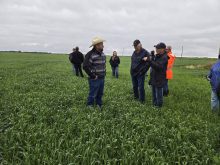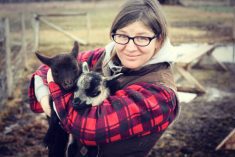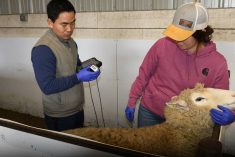An Peischel aimed high when she began breeding goats back in 1985.
“My goals were to produce the highest-quality breeding stock that I could sell to producers and sleep at night, and also to hang the best carcass on the rail off of native vegetation,” the University of Tennessee extension agent said at the recent Multi-Species Grazing Conference here.
Her work began in Hawaii, where conditions range from lush pastures to snow-covered mountain tops, and she obtained bucks in New Zealand during winter because she wanted select breeding stock under the “worst weather and worst possible conditions.”
Read Also

Pig transport stress costs pork sector
Popular livestock trailer designs also increase pig stress during transportation, hitting at meat quality, animal welfare and farm profit, Agriculture and Agri-Food Canada researcher says
In the freezing rain, she hiked into the hills armed with a paintball gun.
“The owner said, ‘Shoot the ones you want, and we’ll bring them down for you on a nice day,’” she said.
In the end, she has settled on the Kiko breed as the basis for her breeding program.
Brush eaters
Over the years, she has selected characteristics that maximize high-lignin, “brush-eating” efficiency, particularly big mouths, big feet, deep bellies with good body capacity, strong bipedal tendencies for reaching higher leaf growth, and especially an ability to consistently produce twins.
Does need to kid quickly in the brush, clean them up and begin nursing immediately, and eat the placenta, which Peischel describes as “very high-quality feed” that can sustain a doe through the first couple of days spent hiding the kids in the “nest.”
“Goats that don’t fit the protocol are pastrami — they become lunch,” says Peischel, who has worked with dairy, meat and fibre breeds.
Culling is done at three and eight months of age, and she looks for lively kids willing to jump off of rocks or trees, but which respect portable electric fences.
Does are also selected as a base for “repeatability” — the capacity to produce predictably uniform offspring — while bucks are chosen based on carcass attributes. She also looks at how birth weight interacts with weaning weight, and how temperament jives with motherability, milkability and milk quality.
Closed herd
Peischel has a closed herd of nine “families” that have been selected for resistance to internal parasites and foot rot, which she calls a “real treat” because it allows her to look for additional behavioural traits.
“I want my does quiet and peaceful,” she said. “They don’t have to like me, but I want them to have a very close social bonding to the group.”
Selecting for bipedalism, or goats that can walk on their hind legs, allows her herd to aggressively reach up and create a “seven-foot browse line.” Longevity is also important. Does are first bred at 18 months but Peischel keeps an “old ladies mob” composed of does over age 12 that have never failed to produce twins.
Udders must be compact with two perfect nipples high above the hocks to enable grazing in rough, thorny environments. Goats with less-than-perfect teeth, or narrow jaws, are culled.
By managing grazing in her brush pastures, she has increased the carrying capacity of the bud regrowth and improved average daily gains from one-third of a pound per day to 0.4 pounds/day with no supplemented hay or grain. Wethers are brought into grazing areas near the farm for about three weeks prior to slaughter and given high-quality hay and fresh water to remove lactic acid from the meat, which causes toughness.
On the carcass side, a key metric is the size of rib-eyes. When she started, they averaged 1.5 square inches. After 10 years they grew to 2.4 square inches, and today are 2.73.
Breeding for carcass characteristics is critical, because consistent size and quality is key for her customers, especially restaurants, said Peischel, whose business is called Goats Unlimited.
“Be careful you don’t select for too many traits at once,” she said. “Genetics takes time, testing and perseverance.”


















